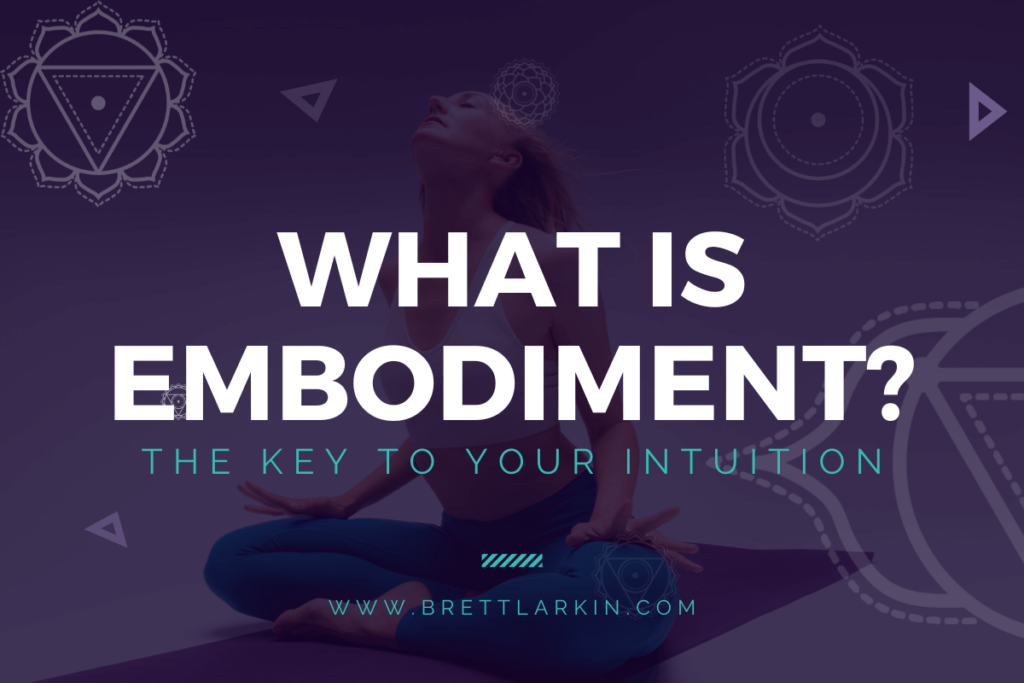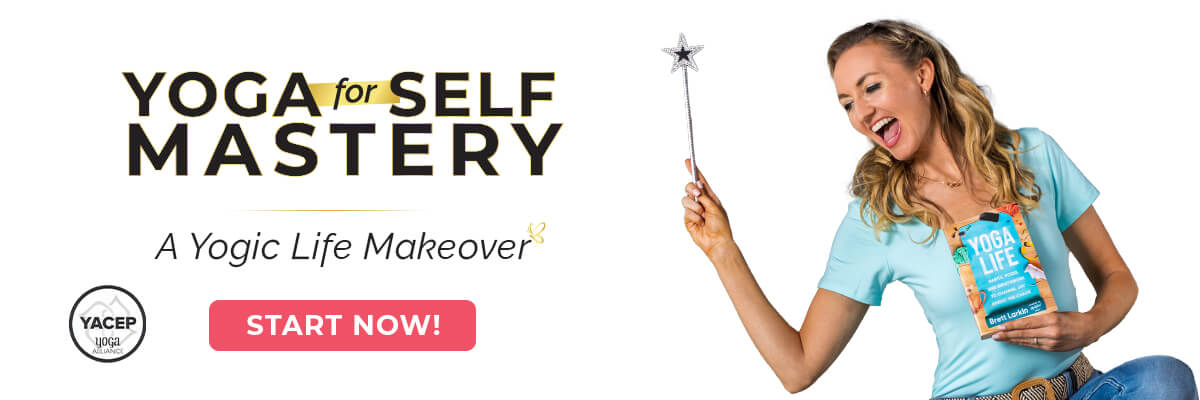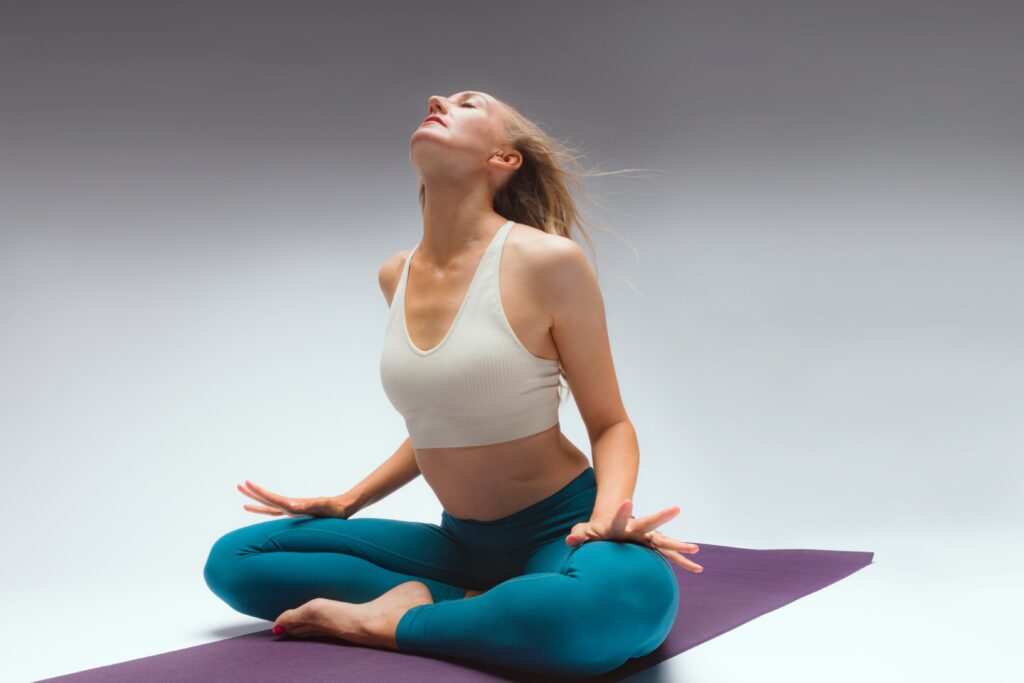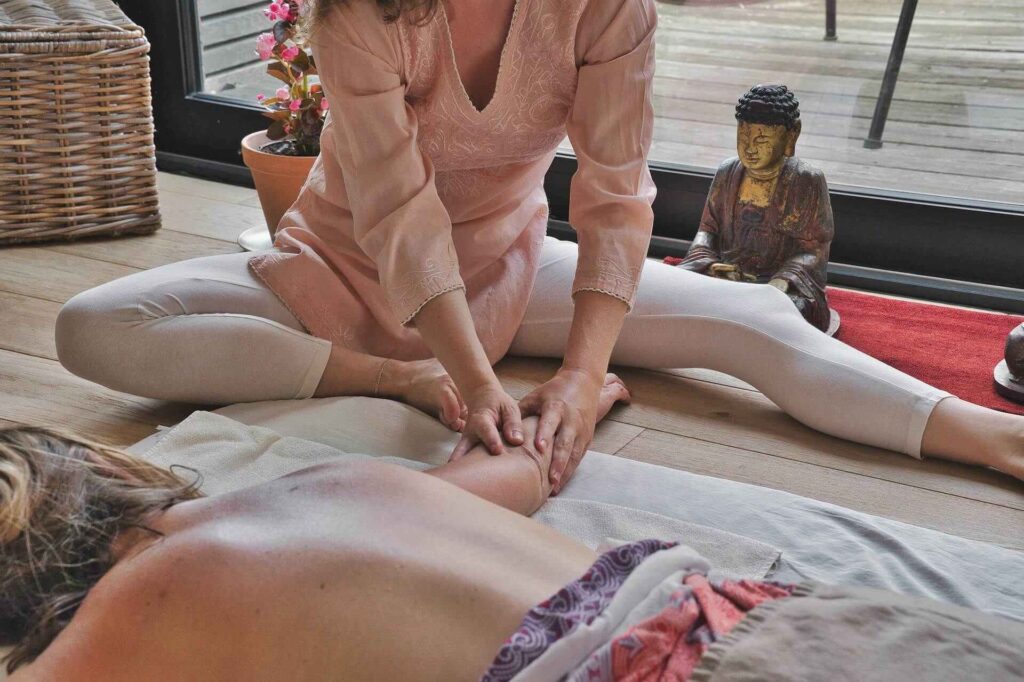So many people are talking about embodiment.
As a yogi, embodiment is most likely already a part of your practice!
But you may not understand what it is or what the philosophy behind it or what the word embodiment even means. You’re not alone!
Luckily, embodiment is my jam and I’m excited to walk you through it.
First, let’s talk about what embodiment is – and how it applies to yoga and your life.
What Is Embodiment?
Embodiment is the profound connection between the mind, spirit, and the body, focused on the integration of the spirit and mind with your physical experience. The word embodiment is about the recognition that your body is the vessel for your mind and spirit – and it’s how you ground the wisdom you gain.
When I think of embodiment, I think of tantric philosophy, the perfect representative for this philosophy. In tantra, a yogi goes UP to attain wisdom (the goal of meditation and a yoga practice), and then brings that wisdom back DOWN into the physical form.
All the spiritual knowledge in the world means nothing if you can’t embody it. The ultimate embodiment happens when you’re able to take what you learn on the mat into your daily life off the mat.
Why Embodiment Matters
In our modern world, so many of us are running around with our heads cut off! In fact, many of us are operating as only our heads – I’m talking about you Zoom! Our world thinks everything is separate.
Now, more than ever, in the age of endless screen time, we need to get back into our bodies.
In ancient, pre-computer times, throughout history, people were moving their bodies all day, every day. Now, we’re living sedentary lives, stuck up in our heads 24/7.
This is why embodiment matters. We need to incorporate movement in order to bring our ideas into the world and influence the future.
Embodied Philosophy
Embodied philosophy emphasizes the lived, sensory experience of the body and its integral role in shaping our thoughts, emotions, and consciousness.
This view runs in direct contrast with society’s traditional view that often separates the mind and physical form. That’s more concerned with mental focus than intuition.
In embodiment theory, your body is the key to your intuition. The key word in that sentence is intuition. Every person has access to their intuition and it speaks a language of its own, one without words. Examples of this include when you have a gut feeling about a situation or you get an idea out of the blue that will solve the problem you’ve been dealing with.
In this type of approach, you are called to act through movement. You allow a new idea to come in while you’re moving in a flow state. This is a core concept of somatic psychology, which acknowledges the interconnectedness of the mind and body in the human existence.
Ever been so nervous you got a tummy ache? Or your body broke out in a rash? Or so stressed you couldn’t sleep? These are an extreme example of how the mind and your physical form are intrinsically linked. On the other end of the spectrum, you might get butterflies when you have an exciting new idea. Or you might feel hope in your heart when you read a piece of writing that inspires you.
In essence, embodied philosophy says that our bodies are not passive containers for our minds, but rather active participants in the creation of our reality. Mind-blown, right?
Let’s delve into the core practices of embodiment:
- Mind-Body Integration: The embodiment concept recognizes the unity of the mind and the body. Embodiment involves acknowledging the impact of bodily sensations, movements, and expressions on your mind. For example, when you listen to soothing music in a bathtub, you’ll experience a soothing sensation in the mind. The only thing to achieve is the release of stress.
- Holistic Healing: Instead of isolating mental or physical symptoms, embodiment considers the whole person, recognizing that emotional and psychological states are deeply intertwined with bodily experiences.
- Embodied Awareness: Embodied philosophy encourages you to cultivate awareness of your bodily sensations and experiences. This awareness is key to shifting your energy.
- Expressive Movement: Expressive movements are a means of self-expression. Movement exploration, especially on the yoga mat, can facilitate emotional expression and energy release through the body. Pretty cool, right?
- Trauma-Informed Approaches: Embodiment needs to be approached from a trauma-informed perspective, recognizing that trauma is not only stored in the mind but also in the body. Embodiment aims to address and release this stored trauma through movement and release.
- Embodiment Practices: Yoga is a perfect form of embodiment and can be enhanced to help you reconnect with your body, regulate your emotions, and release stored trauma.
In essence, the body shapes your experiences, and stores them. Through embodiment practices that honor the mind-body connection, you can embark on a journey towards healing, self-discovery, and balancing your energy.
Embodiment Practices
If you’re like me, you’re probably eager to incorporate more embodiment into your yoga practice and your daily life. There are a few practices out there – from mindfulness to Qi Gong – that are effective.
However, I want to talk about the top three embodiment practices I use and recommend: somatic therapy, yoga, and massage.
Embodiment and Somatic Therapy
Somatic therapy delves into the connection between the mind and body, emphasizing bodily sensations as gateways to emotional well-being. In therapy sessions, you can explore:
- Breathwork: Using breath to release tension and access deeper emotions.
- Somatic awareness Techniques: Cultivating sensitivity to bodily sensations for emotional insight.
- Movement Exploration: Engaging in guided movements to unlock emotional blockages.
I love working with a somatic therapist and highly recommend checking out somatic psychology and therapy if you’re interested.
Embodiment Yoga
Embodiment on the mat is what I’m focused on. To me, embodiment yoga – or somatic yoga – is taking the traditional structure of yoga – the asanas and kriyas we all know and love – and adding in intuitive movement to allow the body to release stored emotions and trauma.
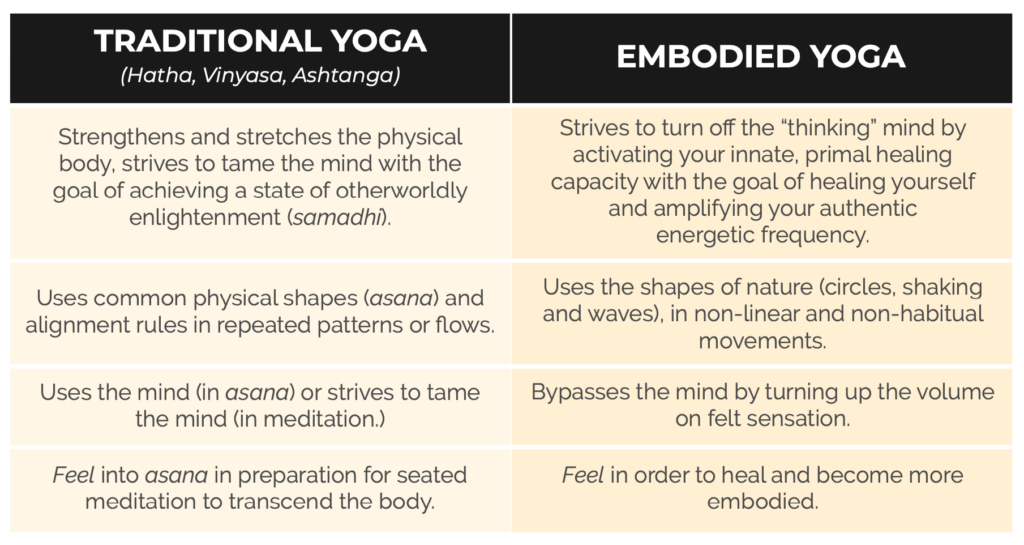
This can be as simple as moving intuitively in Cat/Cow to adopting an entire kriya to incorporate intuitive movement.
The most important factor in practicing embodiment is to always regulate the nervous system first. Before any embodiment yoga practice, it’s essential to deeply relax, so your body feels safe and your nervous system is regulated. From that place, your body knows how to move.
Embodiment Massage
Embodiment massage is a therapeutic approach that recognizes the interconnectedness of the body and mind. It involves:
- Intuitive Touch: Addressing physical and emotional tension through skilled touch.
- Mindful Presence: Being fully present with the client, tuning into their body’s responses.
- Energy Work: Incorporating practices like Reiki to balance and align energy.
If you want to take your massage experience to the next level, try an embodiment massage. This somatic healing experience will make you feel grounded, relaxed, and held.
If all of these practices sound like something you want to learn more about, then doing a somatic embodiment training is a great next step…
Somatic Embodiment Training
If you want to become a certified embodiment coach, the journey involves:
- Foundational Education: Gaining knowledge in somatic psychology, anatomy, and mindfulness.
- Practical Experience: Engaging in supervised practice sessions to apply theoretical knowledge.
- Personal Embodiment: Developing a deep connection with one’s own body and emotions.
- Certification Process: Completing a recognized certification program.
The good news? I’ve developed a certification program that encompasses all 4 of these steps.
In Embodied Yoga Life Coaching, I teach you how to practice embodied yoga – and you get to practice for yourself and with other students in your cohort. By the end of the program, you’ll become a certified Embodied Yoga Life Coach.
Next Steps
- Take a deep dive into embodiment and somatic yoga with my Somatic Yoga certification program.
- If you’re interested in practical kriya yoga as a way to improve your daily life and relationships, check out my Yoga for Self Mastery course.
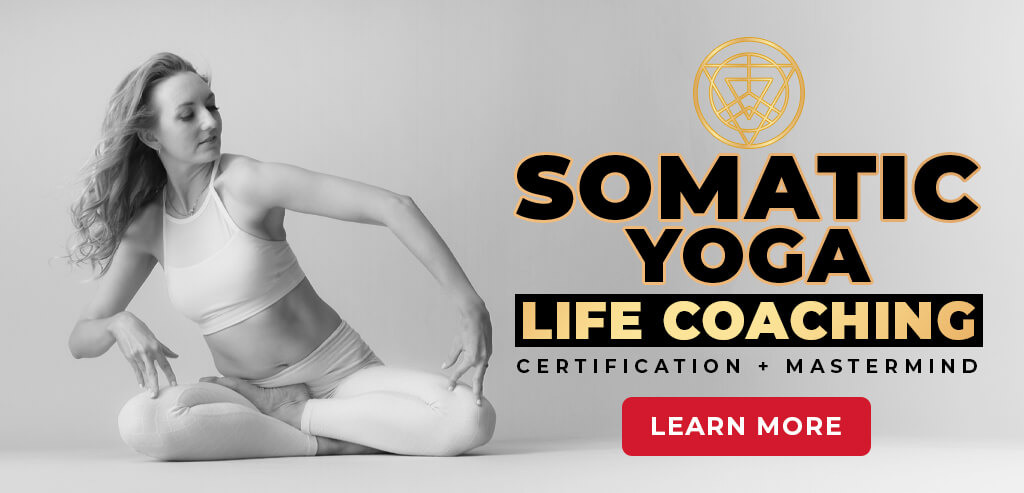
FREE Embodied Yoga Workshop (usually $67) Somatic Techniques & Cord Cutting Ritual
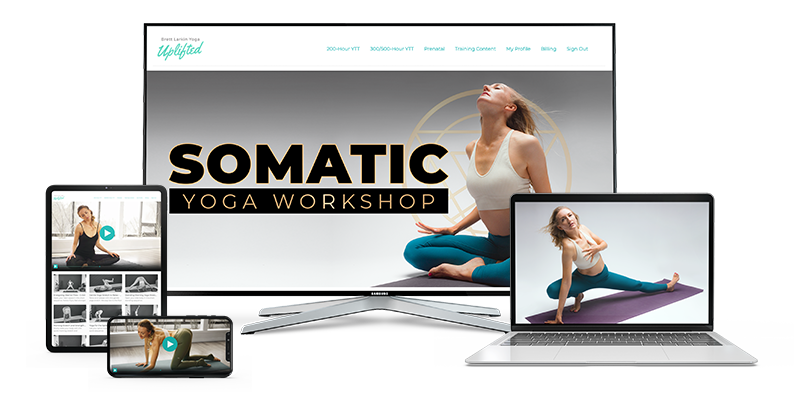
YOU MIGHT ALSO LIKE
- The Perfect Yoga Practice For Your Menstrual Cycle Energy Levels
- Enhancing Your Practice: The Benefits of Yoga and Nature Connection
- Gentle Somatic Yoga for Back Pain: Relief and Prevention Techniques
- How Somatic Yoga for Anxiety Can Help You Find Calm and Balance
- Somatic Stress Release Techniques for Emotional Balance
- Progressive Muscle Relaxation Meets Yoga for Deep Sleep
- 5 Somatic Hip Exercises For Beginners
- How To Relieve Myofascial Pain with Yoga: Heal and Prevent Muscle Tension
- Somatic Energy Healing: Techniques to Realign and Restore Balance
- How Somatic Shaking Can Release Tension and Reset Your Nervous System
- How To Create Mindful Somatic Yoga Sequences Your Students Will Love
- Somatic Yoga Poses For Every Body And Mind
- 6 Hip Openers For Emotional Release
- What Are Myofascial Release Trigger Points?
- Integrating Mind and Body: The Benefits of Somatic Bodywork

